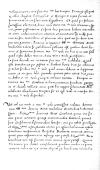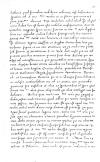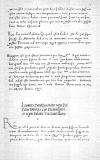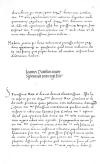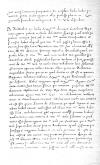Ista hora miserat pro me ⌊serenissimus dominus rex catholicus⌋ et dedit mihi privatam, quam petieram ante, audientiam. ⌊Sacratissima maiestas caesarea⌋ felicissimae recordationis quaedam mihi commiserat in rebus cum ⌊Venetis⌋ ⌊suae catholicae maiestati⌋ referenda, ad quae opportune litterae Sacrae Maiestatis Vestrae venerunt, quarum vigore, rebus nostris agendis sic exigentibus, iterum ⌊suam maiestatem catholicam⌋ nomine Sacrae Vestrae Maiestatis salutavi et rogavi rerum nostrarum iustam et celeriorem expeditionem.
Salutationem ⌊sua maiestas⌋ gratissimo suscepit animo, multa de amore et benevolentia, qua Sacram Maiestatem Vestram amplectitur, disserendo, praesertim quod secretarium suum ad Maiestatem Vestram mittit, qui mentem Maiestatis Vestrae explorare debet, si vellus aureum, cuius ⌊sua maiestas⌋ hoc tempore princeps est, quod ⌊Galliae, Angliae, Portugaliae et Hungariae reges⌋ ferunt, et fraternitatem eiusdem inire dignabitur. Et quod per felicem successum electionis brevi cum Sacra Maiestate Vestra convenire sperat, quam post mortem ⌊caesaris⌋ loco parentis habere intendit et cum eadem maiorem amorem et amicitiam quam unquam fuit cum ⌊caesare⌋ contrahere, et plurima alia, quae, ut scribam, tempus non patitur. Praeterea in negotiis illustrissimae dominae ⌊ducis Mediolani⌋ talem se exhibituram pollicita est, qualem decet bonum et sincerum fratrem Maiestatis Vestrae, cui hac in re non solum quod iuste debet, verum etiam ultra vult gratificari. In fine dicendi me certiorem ⌊sua maiestas⌋ reddidit, quod iste secretarius per postas in duabus horis hinc sit abiturus, si velim scribere Maiestati Vestrae, quod deberet venire in hospitium meum et accipere litteras. Proinde quanto potui citius has exaravi. Dabit Sacra Maiestas Vestra praecipiti calamo veniam.
Pompam introitus ⌊maiestatis catholicae⌋ in hanc civitatem funebrem, et exsequias ⌊maiestatis caesareae⌋ et deinde velleris aurei, quae hic magna solemnitate est celebrata, commodiore tempore, sicut ipse vidi et interfui, Sacrae Maiestati Vestrae describam.
Ut ad res mihi a Maiestate Vestra commissas redeam, bonam cum ⌊illustrissimae dominae ducis Mediolani⌋ oratoribus habemus spem. ⌊Serenissimus dominus rex catholicus⌋, cum res non sit parvi momenti quinque centena milia ducatorum, primis suis consiliariis discutiendam commisit. Iura pro nobis, privilegia et clarissimas inscriptiones, etiam per ipsum hodiernum ⌊regem catholicum⌋ confirmatas ⌊Brussellis⌋ ⌊Brabantiae⌋, tenemus, contra quas quia testamentum infringi non potest, ⌊serenissimus rex catholicus⌋ non nisi summa cum iniuria agere potest. Quaeruntur tamen per dictos consiliarios quaedam media, et prout conicio, talia, ut ⌊rex⌋ etiam aliquid ex hereditate relicta ha{ha}beret. Quod ferendum videbitur, inibimus. Nisi haberetur respectus ad Sacram Maiestatem Vestram, in eo statu, quo nunc res sunt, illustrissima domina ⌊dux Mediolani⌋ nihil aliud quam id, quod nunc habet, hoc est bona ista mobilia, consequeretur.
⌊Sua maiestas catholica⌋ magnam spem rerum suarum in Maiestate Vestra deposuit, hinc res agendae melius habent, facitque mihi hic intuitu Sacrae Maiestatis Vestrae eum honorem, et meo iudicio maiorem, quam aliorum ⌊regum Galliae et Angliae⌋ oratoribus, licet ego reclamo saepius et me non oratorem, ut ex creditivis patet, sed servum et secretarium Sacrae Maiestatis Vestrae dico. Misit pro me ad primum eius huc introitum primos suos duos aulicos, qui me usque ad monasterium, in quo pernoctabat ante civitatem, duxerunt. Deposito bireto coram omnibus me honestissime suscepit et locum cum ⌊Angliae⌋ oratore dedit. Praecedebant ⌊pontificis⌋ et ⌊Galliarum regis⌋, sequebantur ⌊Venetorum⌋, ⌊Ferrariensium⌋ et ⌊Ianuensium⌋ oratores. Sic et in pompis funeralibus et in ecclesia accommodabam me ad ea omnia, non parcendo pecuniis pro vestibus et aliis ea spectantibus et spero, quod Sacrae Maiestati Vestrae, prout aliquando ex aliis intelleget, non fui dedecori. De his, quae mihi Maiestas Vestra pro expensis dedit, restat mihi tantum, quod adhuc per unum mensem vivere possum. Non servatur hic mos iste, qui est apud Maiestatem Vestram, nihil mihi datur neque datum est praeterquam ex penu regio semel quattuor lagenae vini.
Sacra Maiestas Vestra pro sua erga me clementia ulterius providere dignetur, interea tamen dabo omnem operam, ne minima quaedam per me committatur levitas, et sicut consuevi, semper fideliter atque accurate rebus mihi per Sacram Maiestatem Vestram commissis, quantum ingenii et industriae meae est, inserviam. Confido, quod aliquando meae longae iam servitutis erit memor.
Veni ⌊huc⌋ 1519-01-14⌊14 mensis Ianuarii1519-01-14⌋. Introivit hanc civitatem ⌊serenissimus rex catholicus⌋ 1519-02-15⌊15 Februarii1519-02-15⌋. Data mihi est prima audientia in magna consiliariorum frequentia 1519-02-21⌊21 eiusdem1519-02-21⌋. 1519-03-12⌊Hodie1519-03-12⌋ habui privatam, quam credo nostris negotiis prodesse plurimum. Quae quomodo succedent,
cum primis Sacrae Maiestati Vestrae describam.
De falconibus me hodie serenissimus dominus ⌊catholicus rex⌋ interrogavit, quibus multum delectatur, dixitque, quod vult propediem aucupes suos ad Sacram Maiestatem Vestram transmittere, et si rursus habet aliquid, quo Maiestati Vestrae posset placere, offert omnia. Ivit ista hora venatum ⌊maiestas sua⌋, comitatus est eam illustris dominus ⌊Ioannes marchio Brandenburgensis⌋, cui pridie litteras Sacrae Maiestatis Vestrae cum verbis res agendas spectantibus obtuli; praeseferebat bonum vultum et fuit gratissimus de Maiestatis Vestrae, ut mihi tunc videbatur, litteris, pollicitus est omnem operam; nollem tamen illam, quam in ⌊Brabantia⌋ impendebat. Fertur pro certo, quod ducturus est {est} in uxorem ⌊reginam⌋ relictam viduam serenissimi regis ⌊Ferdinandi⌋ nuper defuncti. Habet magnam apud ⌊serenissimum regem catholicum⌋ auctoritatem; sunt tamen plures, qui maiorem, presertim illustris dominus ⌊Guliernus de Croy⌋, dux ⌊Sorae⌋, regni Neapolitani admiratus, quem ⌊maiestas caesarea⌋ in celebratione velleris aurei in marchionem creavit, titulus nunc mihi non occurrit, et est iste, quem dicunt de Szeveres, qui apud ⌊regem⌋ in manibus habet omnia.
Maluissem ad ⌊illum⌋ Maiestatis Vestrae habuisse litteras. Nihilominus ego imprimis, antequam primam haberem audientiam, eum nomine Sacrae Maiestatis Vestrae salutavi et quod notus esset fama ingenti Maiestati Vestrae per oratorem, qui a Maiestate Vestra superioribus annis fuit in ⌊Brabantia⌋ apud ⌊caesarem⌋, persuasique ei, magnam habere Sacrae Maiestati Vestrae gratiam etc. Iste rebus nostris non nocuit, immo promovit plurimum. Accepit ab illustrissima ⌊domina duce Mediolani⌋ corruptiones facturusque est omnia, si adhuc litterae Maiestatis Vestrae ad eum darentur, in omnem eventum, nam suspicor, mihi adhuc esse in negotiis istis immorandum, quae tam subito confici non possunt, quia omnia desuper iura conquiruntur. Non parum iuvaret nos ista curia, habet etiam practicas suas. Sunt hic ut fuerunt in aula ⌊caesaris⌋ plurimi, qui merito geswindt dici possunt. Bene tamen speramus.
Novi hic nihil habetur, quam quod istis diebus iste, de quo supra scripsi, ⌊de Szeveres⌋, debet ire et convenire cum gran magistro Franciae ad utriusque regis negotia tractandum. Quid erit, postea experiemur.
Magna est spes istius electionis pro ⌊serenissimo rege catholico⌋, dicitur etiam saepius de Maiestate Vestra, ego taceo, addo tamen hoc, quod Maiestas Vestra non est nimirum ambitiosa. Sacra Maiestas Vestra pro sua prudentia, quid expedit, facile perpendet. Sunt tamen hic multi, potissimum ⌊Itali⌋, qui Maiestatem Vestram ⌊Cracoviae⌋ et ⌊Viennae⌋ viderunt, qui Maiestati Vestrae imperium imprecantur. Sed adest iste secretarius, qui litteras has exspectat.
Commendo me suppliciter Sacrae Maiestati Vestrae.
